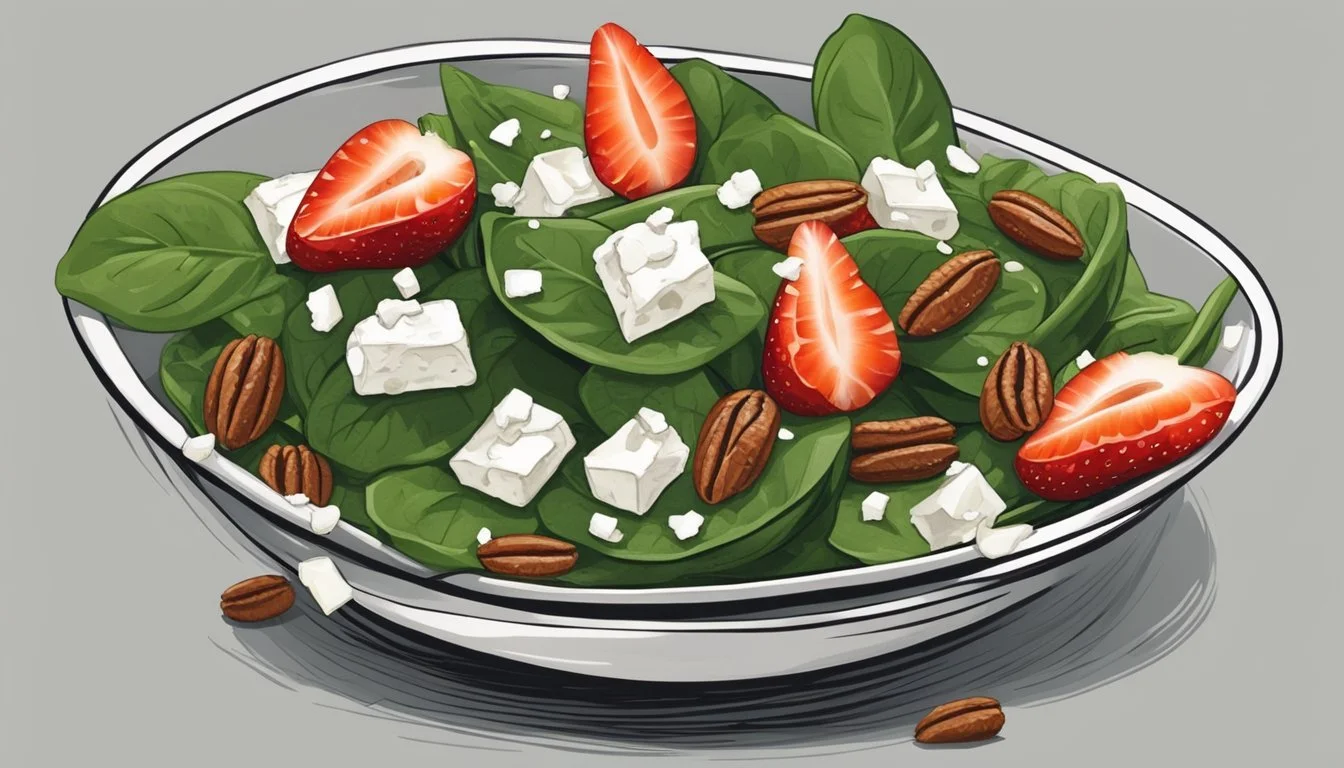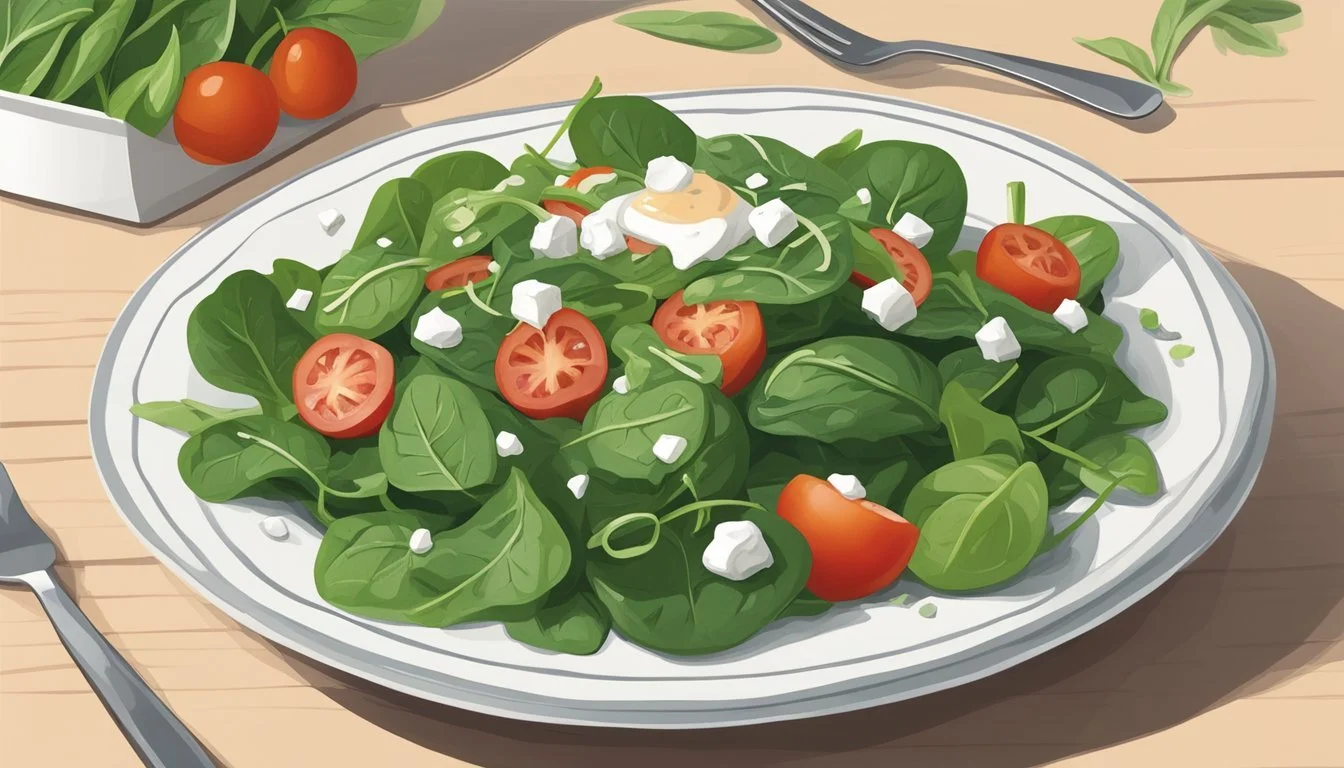How Do You Eat a Spinach Salad?
Tips for a Healthy & Flavorful Meal
Eating a spinach salad is a nutritious and versatile culinary experience. Spinach (What wine goes well with spinach?), a leafy green packed with essential vitamins and minerals, serves as a blank canvas for an array of ingredients. Whether it is tossed with a simple dressing or combined with robust flavors like feta cheese and smoky pecans, spinach salad can accommodate diverse tastes and dietary needs. Its ease of preparation makes it a go-to meal for those seeking healthful options without compromising on flavor.
The key to a delightful spinach salad lies in the balance of textures and flavors. Fresh spinach leaves provide a tender base that pairs well with a variety of add-ins such as hard-boiled eggs, crisp apple slices, juicy tomatoes, and earthy mushrooms. Enhancing the salad with a dressing—whether it's a classic balsamic vinaigrette or an inventive blend of olive oil, apple cider vinegar, and Dijon mustard—can tie the components together into a cohesive dish. Additionally, toppings like sesame seeds or nuts add a satisfying crunch that elevates the overall eating experience.
When preparing and serving a spinach salad, one should pay attention to the freshness of the ingredients and the timing of dressing application. To maintain the leaves' integrity, the dressing should be drizzled just before serving to ensure the greens remain crisp and vibrant. With a careful selection of components and attention to detail, anyone can enjoy a delicious and healthful spinach salad that caters to their personal taste preferences.
Choosing Ingredients
Creating a delicious spinach salad involves selecting a variety of fresh, flavorful components that balance taste and nutrition. The choice of spinach, produce, proteins, cheeses, and fats greatly influences the overall quality of the salad.
Selecting Spinach Varieties
Choose spinach based on preference and texture desired. Baby spinach offers a tender option, perfect for salads (What wine goes well with salads?), while mature fresh spinach holds up well with robust dressings. Kale and arugula (how long does arugula last?) can add a peppery note, making for an interesting mix.
Incorporating Fresh Produce
Include a variety of vegetables and fruits to enhance the salad. Consider sliced mushrooms, cucumbers, and cherry tomatoes for a refreshing crunch. Red onion and shallots lend a sharp, vivid flavor, while berries, apples, or peaches contribute a sweet, fruity element.
Adding Proteins
Proteins can transform your spinach salad into a filling meal. Incorporate hard-boiled eggs or slices of salmon for high-quality animal proteins. For plant-based options, include roasted chickpeas or nuts such as almonds, pecans, and walnuts.
Selecting Cheeses
Cheese adds a creamy, indulgent aspect to salads. Feta cheese and goat cheese provide a tangy flavor, while parmesan adds a salty, umami kick. For dairy-free diets, opt for cheese alternatives or simply omit this element.
Integrating Extra Flavors
Maximize flavor with thoughtful extras. Homemade croutons offer a satisfying crunch, while dried cranberries or candied pecans introduce a hint of sweetness. Sunflower seeds add both texture and a nutty profile.
Embracing Healthier Fats
Choose olive oil for its heart-healthy monounsaturated fats, used in making vinaigrettes. Nuts contain polyunsaturated fats, which are also beneficial. When using cheeses or bacon (how long does bacon last?), keep in mind they may contribute higher levels of saturated fat. Choose these in moderation to maintain balance.
Creating the Perfect Dressing
Crafting the ideal salad dressing is a balance of flavors and the proper emulsification technique. This section explores the nuances of creating a vinaigrette, as well as experimenting with various sweet and savory combinations to enhance your spinach salad.
Mastering Vinaigrettes
A good vinaigrette is a simple emulsion made of oil and vinegar. The classic ratio is three parts oil to one part vinegar, but one can adjust it according to their taste. For a balsamic vinaigrette, they would blend together balsamic vinegar with olive oil, adding ingredients like salt, black pepper, and a little Dijon mustard to emulsify and enhance the flavor. Achieving the right consistency is key; it should be smooth and well-blended.
Ingredients for a Basic Vinaigrette:
3 parts Olive Oil
1 part Vinegar (Balsamic, Red Wine Vinegar, etc.)
Kosher Salt and Black Pepper to taste
Dijon Mustard to emulsify
To prepare, they can whisk these components together in a bowl or shake them up in a jar with a tight-fitting lid until they are thoroughly combined.
Exploring Sweet and Savory Combos
One can take their dressing to new levels by experimenting with sweet and savory flavor profiles. Adding honey or maple syrup to a basic vinaigrette can impart a subtle sweetness. For a savory twist, a warm bacon vinaigrette is an excellent choice, especially with spinach salads. They would render bacon in a pan, combine the fat with vinegar and a touch of sugar if desired, then drizzle it over the salad for a rich, flavorful dressing. For extra zing and freshness, a squeeze of lemon can be an invigorating addition.
Ingredients for a Sweet and Savory Vinaigrette:
Bacon Fat or Olive Oil
Vinegar
Sugar, Honey, or Maple Syrup (optional)
Lemon Juice (optional)
Salt and Pepper to taste
To create this dressing, they would combine the chosen sweetener with the savory ingredients and whisk or shake until the dressing reaches a desirable consistency and flavor balance.
Salad Assembly and Presentation
Creating an appetizing spinach salad involves thoughtful layering of ingredients, proper tossing techniques, and eye-catching garnishes. The visual appeal is nearly as important as the taste when it comes to serving a salad that truly stands out.
Layering Ingredients
A spinach salad begins with a foundation of fresh spinach leaves, which should be crisp and well-rinsed. For a balanced flavor and texture, arrange thinly sliced apples or strawberries if making a fruit-centric spinach salad. For a classic approach, one can add crumbled hard-boiled egg and cooked, chopped bacon. Ingredients should be distributed evenly to ensure each bite is a blend of all components.
Tossing Techniques
Gently tossing the salad is crucial to coat the ingredients without bruising the spinach leaves. It’s best to drizzle the dressing—whether a homemade vinaigrette or a creamy alternative—around the perimeter of the bowl, then fold the ingredients from the bottom up, rotating the bowl to integrate the dressing evenly.
For Croutons, Nuts, and Seeds:
Adding these just before tossing minimizes sogginess.
Garnishing to Impress
The final touch is garnishing, which elevates the presentation. Sprinkle a modest amount of nuts or seeds for a pleasing crunch and visual contrast. If using cheese, such as feta or goat cheese, scatter it atop so it stands out. Consider a final drizzle of dressing or a sprinkle of fresh herbs for color and freshness.
Nutritional Information
When one considers incorporating spinach salad into their diet, the nutritional profile is noteworthy due to its low calorie content and rich supply of vitamins and minerals. A spinach salad offers a beneficial blend of macronutrients and micronutrients essential for health.
Counting Calories and Fat
A typical serving of raw spinach, about 3.5 ounces (100 grams), contains approximately 23 calories and 0.4 grams of fat. Spinach salads can vary in caloric content depending on the ingredients added, such as dressings and toppings. For instance, a standard serving of spinach salad with various accompaniments can have around 134 calories, with the fat content largely influenced by the dressing and added elements like cheese or nuts.
Nutrient Amount per Common Serving Calories ~134 kcal Total Fat ~10 g Saturated Fat ~3.7 g Sodium (varies) Depending on dressing and added ingredients Fiber 2.2 g
Understanding Micro-Nutrients
Spinach is a powerhouse of micronutrients that contribute to numerous health benefits. It is exceedingly high in vitamin K, necessary for blood clotting and bone health, providing over the recommended daily amount in just one cup. Spinach is also a good source of vitamin A, vital for skin and eye health, vitamin C, an antioxidant that supports the immune system, and folate, essential for DNA synthesis.
Furthermore, it offers important minerals such as iron, vital for blood production, potassium, contributing to heart function, and calcium, necessary for bone health.
Vitamin/Mineral Benefit Vitamin A Supports skin and vision Vitamin C Antioxidant aiding immunity Calcium Critical for bone health Iron Necessary for blood cell production Potassium Maintains proper heart function
Spinach is also a part of a heart-healthy diet, as it's low in cholesterol and contains a favorable amount of fiber, which can aid in digestion and maintaining healthy blood sugar levels. The nutritional composition of spinach makes it an excellent choice for those looking to enrich their diet with essential vitamins and minerals while managing caloric intake.
Pairing with Meals
Eating a spinach salad is an enjoyable experience when it is well-paired with complementing dishes for a meal. The key consideration is achieving a satisfying balance in both taste and nutrition.
Complementing Main Dishes
In considering main dishes to pair with a spinach salad, chefs often recommend proteins to add both flavor and substance. For a hearty meal, one might opt for grilled salmon (What wine goes well with grilled salmon?), which offers a rich taste and omega-3 fatty acids. Additionally, baked ziti or sirloin tip roast pair well with the lightness of spinach. For those favoring poultry, marinated chicken serves as a versatile and simple-to-prepare option.
When serving seafood lovers, incorporating options like garlic shrimp—lightly seasoned and sautéed—adds a complementary texture and taste. One can't ignore the excellence of Maryland crab (What wine goes well with crab?) cakes for a more decadent pairing.
For vegetarian guests, a spinach salad goes well with eggplant parmesan (What wine goes well with eggplant parmesan?) or lemon pepper tofu bites. These dishes provide a satisfying umami flavor that balances the fresh crispness of the spinach.
Creating Balanced Menus
Crafting a well-rounded menu involves including a variety of food types that cater to different tastes and dietary needs. When planning a dinner menu, chefs may begin with a simple easy spinach salad, incorporating apples for sweetness and smoky pecans for crunch.
For a lighter accompaniment, one might include a comforting soup, which can serve as both a warm introduction to the meal or a side to the salad. When considering grains, quinoa or orzo might be offered either as part of the salad or as separate dishes.
Pasta, with its many forms, can act as a canvas for bold flavors and pairs well with spinach salad, especially when it is dressed with a tangy balsamic vinegar dressing. This balance of earthy greens and robust pasta can create a dining experience that satisfies without overwhelming the palate with richness.
Ultimately, a spinach salad can fit seamlessly into various menus, from an elegant dinner affair to a casual lunch—its versatility in pairing allows it to complement a wide array of mains and sides, creating a coherent and enjoyable meal.
Customizing Your Salad
Creating a satisfying spinach salad involves more than just tossing ingredients into a bowl. It's about respecting dietary restrictions, embracing the variety offered by different seasons, and being open to experimenting with various greens. Here's a guide to making your spinach salad enjoyable for all.
Dietary Considerations
For those following a vegan or dairy-free diet, replacing traditional cheese with tofu fresco adds a similar texture and protein without compromising dietary needs. Dressings often contain hidden animal products, so one should opt for oil and vinegar-based dressings or check labels carefully. Additionally, using a paper towel to pat down washed greens can ensure they are dry, which helps vinaigrettes adhere better without the use of additives.
Adapting to Seasons
A vibrant salad reflects the flavors of its components, which should be chosen based on their seasonal peak. For instance, summer fruits like strawberries and peaches add sweetness and are at their most flavorful in warmer months. Conversely, seasonal vegetables like roasted butternut squash (how long does butternut squash last?) bring a heartiness suitable for cooler seasons. Here's a quick reference:
Summer: Add berries, stone fruits, or cucumbers.
Fall: Introduce roasted nuts, seeds, and squash.
Winter: Opt for pomegranate seeds or citrus segments.
Spring: Embrace tender greens and early radishes.
Switching Up the Greens
While spinach is a great base, one shouldn't shy away from incorporating or substituting other leafy greens such as kale or arugula to adjust the flavor profile and texture of the salad. Kale offers a heartier chew and a slightly bitter taste, while arugula presents a peppery note. They can be used solely or mixed with spinach for a more complex dish. A simple format to follow could be:
50% Spinach: for classic flavor and tender texture.
25% Kale: for a chewier, heartier bite.
25% Arugula: for a bold, peppery kick.
When altering greens, one should keep in mind the balance of flavors to ensure complementary pairings with chosen dressings and toppings.
Storage and Leftovers
Maintaining the freshness of spinach salad is crucial for both taste and health reasons. Proper storage techniques can significantly extend its lifespan, while knowledge on revitalizing a second-day salad ensures that leftovers remain appetizing.
Proper Storage Techniques
When storing spinach salad, one should keep it in the refrigerator within two hours of preparation to prevent bacterial growth. For optimal freshness, raw spinach should be placed in an airtight container with a dry paper towel to absorb excess moisture. This method can keep the spinach crisp for up to a week or ten days.
Spinach Salad: Store prepared salad in an airtight container.
Shelf Life: Up to 5 days in the refrigerator.
Moisture Control: Place a dry paper towel above and below the salad leaves to absorb moisture.
Revitalizing Second-day Salad
If the spinach salad appears slightly wilted the following day, one can revive its crunchiness before serving. Drizzle a small amount of olive oil over the leaves, which can help them regain some of their natural crispness.
Revitalization Technique:
Lightly toss the salad with a sprinkle of olive oil.
Consume promptly for best texture and flavor.
Conclusion
Eating a spinach salad is a delightful way to incorporate fresh produce into one's diet. These salads can range from simple to elaborate, depending on the recipe and the desired nutrition profile. Nutrient-rich spinach forms the salad's foundation, with possible additions including hard-boiled eggs, apple slices, smoky pecans, and feta cheese, among other ingredients.
For those seeking a Mediterranean flair, cherry tomatoes, cucumber, olives, (What wine goes well with olives?) and feta provide a refreshing twist, with a dressing of lemon and olive oil complementing the flavors. Another nutritious option involves a warm salad with sautéed spinach, garlic, shallots, quinoa, roasted sweet potato, and a poached egg, marrying taste with health benefits.
When it comes to dressing, preferences vary. Some diners prefer a classic homemade vinaigrette while others may opt for a zesty lemon and olive oil dressing. It is important to mix the dressing well, whether that’s shaken in a jar or whisked in a bowl, then drizzle it lightly over the salad to maintain the delicate balance of flavors.
Regardless of one's choice, the key is in the quality of ingredients—ensuring they are fresh and seasonal whenever possible. This not only supports local agriculture but often results in superior taste and nutritional value.
In selecting ingredients, thoughtful consideration can lead to a delicious and nutritious meal that energizes the body while satisfying the palate.










